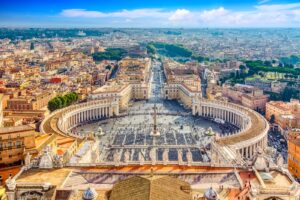As the world’s financial markets continue to limp along under the burden of insufficient liquidity and amid ongoing doubts about many financial institutions’ basic solvency, governments are focusing on how to jumpstart their economies out of recession. In some quarters, tax-cuts have been mentioned as part of a possible range of options. Far more governments, however, are opting for the type of interventionist policies traditionally associated with the economist John Maynard Keynes, whose writings in the 1930s revolutionized the way that most economists understood the very nature of economic science. Though many—if not most—of his ideas were discredited by the stagflation that crippled Western economies in the 1970s, Lord Keynes seems to be back in fashion today.
A little discussed question, however, is whether Keynesian-inspired policies are more likely in the long-run to actually foster one of the major causes of the current financial crisis. Among other things, Keynes is famous for his remark that “in the long-run, we are all dead.” To be fair to Keynes, this comment from his Tract on Monetary Reform (1923) is invariably cited out of its original context. But there is no escaping the fact that Keynesian policies ignore a major factor underlying our present economic problems: moral hazard.
Moral hazard is a term commonly used to describe those situations when a person or institution is effectively insulated from the possible negative consequences of their choices. This makes them more likely to take risks that they would not otherwise take, most notably with assets and capital entrusted to them by others. The higher the extent of the guarantee, the greater is the risk of moral hazard.
The mortgage lenders Fannie Mae and Freddie Mac are prominent examples of this problem. Implicit to their lending policies was the assumption that, as government-sponsored enterprises with lower capital requirements than private institutions, they could always look to the Federal government for assistance if an unusually high number of their clients defaulted. In a 2007 Wall Street Journal article, the Nobel Prize-winning economist Vernon Smith noted that both Fannie Mae and Freddie Mac were always understood as “implicitly taxpayer-backed agencies.” Hence they continued what are now recognized as their politically-driven lending policies until both suffered the ignominy of being placed in Federal conservatorship last September.
Start your day with Public Discourse
Sign up and get our daily essays sent straight to your inbox.Consider, too, the legal protection of limited liability. On one level, this arguably encourages managers and investors to take full advantage of the massive wealth-creating potential often associated with high-risk endeavors. But at the same time, limited liability also tends to shelter these individuals from a major incentive not to take excessive risk: the prospect of personal bankruptcy. As observed in 1971 by another Nobel Laureate in economics, Kenneth Arrow, limited liability regulation creates incentives for people to do things that they might not do if they were subject to the provisions of unlimited liability. “The law,” Arrow wrote, “steps in and forces a risk shifting not created in the market-place.”
At the level of government policy, a prominent instance of moral hazard was what some call the “Greenspan doctrine” of 2002. This involved the U.S. Federal Reserve stating that, while it was powerless to prevent the emergence of asset bubbles (such as the dot-com and housing booms), the Federal Reserve would do everything that it could to soften the effects of an imploding bubble. This included providing investors with the option of selling their depreciated assets to the Federal Reserve at a time of crisis. Not surprisingly, the result was a surge in excessive risk-taking by investors confident that, if everything did not proceed as planned, they could recoup their losses at someone else’s expense. In his recent book, Fixing Global Finance (2008), the financial journalist Martin Wolf underlines “the distortions introduced by government guarantees to risk-taking.” These, he writes, “create an overwhelming incentive to privatize gains and socialize losses.”
In many respects, the “Big Three” American car companies are (barely) living examples of what sometimes happens to specific industries when the danger of moral hazard is underplayed. When the Carter Administration chose to rescue Chrysler in 1980, this action conveyed a message to the three Detroit-based car manufacturers: they could take the risk of producing cars that fewer and fewer consumers apparently wanted to buy; they could also risk refraining from confronting the serious inefficiencies introduced into their companies’ operations by years of automobile executives acquiescing in outlandish demands from the United Automobile Workers union. Why? Because if the car companies subsequently found themselves facing economic Armageddon, they had high expectations—based on an established policy-precedent—that the Federal government would bail them out.
Thus, no one should have been surprised to find the chief executive officers of the now not-so-Big Three—accompanied by a legion of lobbyists and the ever-present UAW—appearing before the United States Congress in late 2008 requesting assistance in order to avert bankruptcy. Does anyone doubt that the next time the Big Three skirt the edge of insolvency, they will once again request protection from the consequences of bad decisions? Such is the logic of disdaining moral hazard.
While there is a great deal of literature on the economics of moral hazard, the same material contains curiously little reflection on why the adjective “moral” is attached to the word “hazard.” Indeed, when economists started studying the subject of moral hazard in the 1960s, their analysis rarely included an explicitly ethical dimension. For the most part, this remains true today. So why do we not simply describe these situations as instances of “risk hazard”?
It may be that the word “moral” reflects some innate, albeit largely unexpressed, awareness that there is something ethically questionable about creating situations in which people are severely tempted to make imprudent choices. To employ a loose analogy from the realm of moral theology, the one who creates “an occasion of sin” bears some indirect responsibility for the choices of the person tempted by this situation to do something very imprudent or just plain wrong.
If governments and businesses took moral hazard seriously, they would make an effort to identify those state and non-state structures, policies, and practices that create incentives for people to take excessive risks with their own and other peoples’ assets. They would then do what they could to minimize these instances of moral hazard. The economic price might be fewer booms. But economic growth over time would likely be steadier. The chances of mild or severe recessions would also be reduced.
This brings us to back to the Keynesian policies that most governments are adopting to address the current crisis. In a 2007 Financial Times column, a prominent member of the former Clinton and now Obama Administration’s economic team, Larry Summers, argued that we should beware of what he called “moral hazard fundamentalism.” This was, he said, “as dangerous as moral hazard itself.” By this, Professor Summers meant that ruling out significant government economic intervention on the grounds that it might encourage moral hazard would itself be irresponsible.
The problem is that the Keynesian-interventionist outlook involves, by necessity, a degree of systematic denial of the reality of moral hazard. In an attempt to maintain full employment in perpetuity, Keynesian policies embrace measures ranging from keeping interest-rates artificially low, partially nationalizing industries, to engineering large public works programs. An unfortunate effect is that many businesses as well as ordinary consumers become somewhat insulated from many of the negative consequences of poor decisions and bad investments. As a result, some will become complacent, which is the road to economic stagnation. Others, however, are likely to take risks that become increasingly irresponsible over time until we find ourselves in situations similar to our current predicaments.
Of course, as long as human beings are fallible creatures, many will take excessive risks at different points in their lives. For some people, it will be with their marriage. Others will behave in an excessively risky manner with their own and others’ financial resources. As a consequence, some people will suffer losses. In a society where right reason and the ethic of loving one’s neighbor reigns, individuals and communities should be ready to help those in genuine need. Law also has a potentially important role to play. As the legal philosopher John Finnis observes in Natural Law and Natural Rights (1980), a sound bankruptcy law can meet all the demands of justice—legal, commutative, and distributive—while respecting the dignity of all those effected, especially the dispossessed, but also those at fault. But neither we nor governments do anyone any favors by creating circumstances or incentives that encourage people to behave imprudently and recklessly in the worlds of finance and industry.
In his many works, the German economist Wilhelm Röpke noted that we should never forget the economic implications of one of the famous pensées of the seventeenth-century French mathematician, philosopher, and physicist Blaise Pascal: “L’homme n’est ni ange ni bête, et le malheur veut que qui veut faire l’ange fait la bête” [Man is neither an angel nor a brute, and the misfortune is that he who wants to make the angel makes the brute]. Röpke’s point was that basing economic policies on the pretence that humans are angels is likely to encourage some rather un-angelic behavior. This is advice that governments should keep in mind if they do not want their response to the present recession to sow the seeds of a future economic crisis. Taking moral hazard seriously would be a welcome first step.












